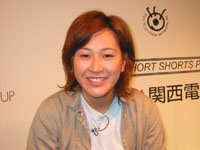 |
|
 |
|
'Wolkan Tact' won first-time director Sanae much praise and attention at its debut in Los Angeles at
the SSFF kick-off screening (held in May at the historic Egyptian Theatre). Most audience members were
struck by the film's original format - the story is told in two frames, side-by-side, a conductor in
black & white on one side, the story in the other frame, in color - and its funny story, about how a
girl easily mistakenly thought her boyfriend was cheating on her. And yet, for all the film's sophistication,
Sanae says it was simple to make. "I made the film mostly with high school friends. The lead boyfriend's mother is actually my own mother. The equipment is all school equipment, so we didn't have to pay to use it. I think the only thing I spent money on were the tapes. And we did the non-linear editing on a home computer. We kept it pretty simple." Just how did Sanae come up with the idea for the double frames? "Originally, I wanted to show the (girl's) emotions through some form of physical movement. I took my cue from TV broadcasts, which (in Japan) often have a translator for the hearing-impaired, someone using hand signals to simultaneously translate the broadcast. So I took it a step further and thought it would be neat to use an orchestra conductor with his baton. And I decided that the conductor should be the one setting the pace, almost telling the story, so I set the two frames up, one in color and the other with the conductor in black and white." And the result is striking - it's as if the conductor really is mastering the direction of the story. "One of the things that struck me initially about this music is how it was very, in Japanese we say, 'ki-sho-ten-ketsu,' literally, it has the traditional rules of how to compose a Chinese poem, which require that it contains an introduction, development, a turn and a conclusion. Also, I thought the music's male chorus was interesting, and would probably make people laugh, which is why I chose it." For Sanae, becoming a film director was never a lifelong dream, but something she sort of fell into. "I like watching films, but I've long been interested in graphics design, which I studied in college. But it was through those studies that I became more interested in pictures, imagery." And speaking of filmmaking and short films in Japan, Sanae thinks that "there still isn't much of a strong foundation in Japan for making short films. Sure, I'd like to make a movie using film, especially if I could make them and easily show them. But it's also pretty easy and simple to make films using digital video, and it's easy to edit those into films. I want to continue making films with my friends, and, I think if other people want to make films, they can and should and they should try to have fun while they're making them." |